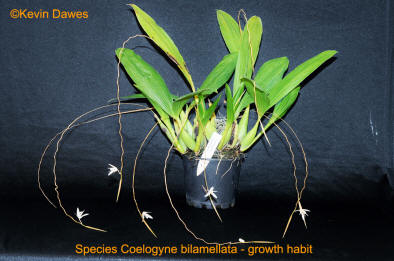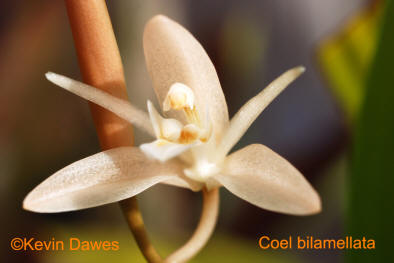Not well known, Coelogyne bilamellata would be low down in the order for home orchid growers but an interesting orchid for a collector. From the Philippines and Borneo, it grows on trees and rocks below 1000m. Therefore, avoid frosts completely. Provide partial shade and water well.
This is another 'old' Coelogyne, being named in 1854 by Dr John Lindley and named because of its two (Latin = bi) flattened ridges/keels (Latin = lamella) on the lip.
Coelogyne bilamellata is one of a group of similar-looking Coelogynes that include prasina, and longifolia. Coel bilamellata produces small flowers about two centimetres across and one at a time but it just keeps on flowering. The spike keeps extending until many months later it will have produced 50 or 60 flowers and the spike will have grown to nearly a metre long. The pale pink flowers are quite dainty and frail looking and their pale semi-translucent texture is very appealing. The almost continually flowering trait would make a good gene to introduce into hybrids. It is hardy and easy to grow in intermediate conditions.
An identifying feature is that the two only keels on the flower lip are almost fused into one towards the base of the lip.
Negatives: The flower spikes start off erect but as they get older they form long, thin, straggly spikes that can't support their own weight and tend to collapse and be lost in any surrounding foliage. This, together with the small flower size means that they get totally lost and overlooked in the greenhouse. Their growth habit also means that they aren't spectacular as a specimen plant. The best way to grow this orchid is from a high hanging basket with a lot of clearance around it.
Rating: ♦♦
Sometimes sold as: No other labels
Varieties: Jim Cootes, in his book, The Orchids of the Philippines, has an image of a white unnamed variety but the flowers are normally a caramel colour.
Hybrids:
1. Coelogyne Kirribilli Noela was registered in February 2013 by Kevin Dawes using Coel flexuosa as the pod parent.
| < Coel barbata | Coel brachyptera > |

